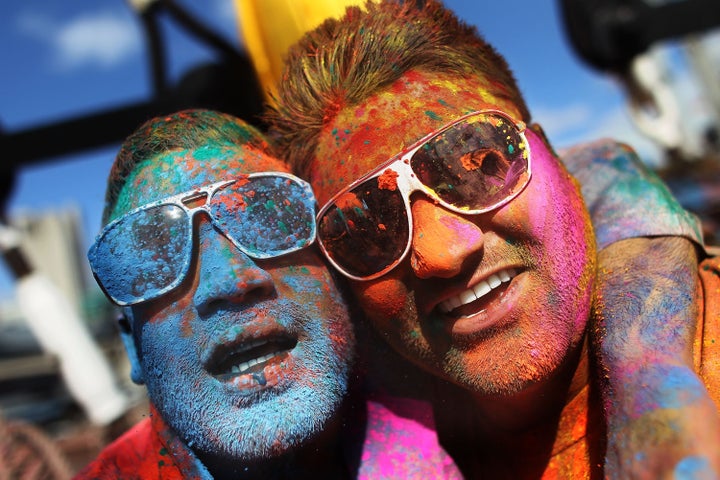
The Immigration and Nationality Act of 1965 opens up Asian immigration. Transcendental Meditation takes off. Young people in shaved heads and saffron robes chant "Hare Krishna" at airports.
In the 1960s and 1970s, Hinduism seemed on the path to spectacular growth in the United States as immigration laws eased and some Indian spiritual leaders were embraced by the counterculture of the l960s.
The forecasts were half right.
Transcendental Meditation and movements such as the International Society for Krishna Consciousness would face growing anti-cult opposition, among other obstacles. They would not be the path to lasting growth in Western converts to Hinduism.
What is propelling Hinduism in the United States into a role as one of the nation's largest minority religions is a steady stream of Indian immigrants who have built hundreds of temples across the nation, according to a new study.
In what it calls the first effort to conduct a Hindu census in the United States, the Santa Barbara, Calif.-based Institute of American Religion discovered some 1,600 temples and centers with an estimated 600,000 practicing Hindus.
That number could easily rise up to the estimated 1.2 million who self-identify as Hindus in national studies by adding in the mostly Indian Americans who limit their involvement to private spiritual practices or celebrations of semi-secularized holy days such as Diwali, said J. Gordon Melton, the institute executive director. Melton announced the results of the census at the recent annual meeting of the Association for the Study of Religion, Economics and Culture in Washington.
For better and worse, however, the latest incarnation of Hinduism in the United States has gone largely unnoticed by most Americans.
Immigration Gains
Hinduism was introduced to the United States through the 19th century translation of texts such as the Bhagavad Gita. The first Indian teacher to visit the U.S., P.C. Mozoomdar, spoke in 1830 at the home of Ralph Waldo Emerson, Melton and Constance Jones of the California Institute for Integral Studies noted in a paper presented at the Washington conference.
Other gurus followed, but the growth of the Hindu community was cut short by the Asian Exclusion Act in 1924, Melton and Jones said.
The comeback began in 1965 with the new immigration law opening the U.S. to Indian immigrants. Among the prominent spiritual leaders to come over were Maharishi Mahesh Yogi, founder of the Transcendental Meditation movement, and Swami Bhaktivedanta Prabhupada of the Krishna society.
Many Americans welcomed the gurus, but interest among non-Indians faded in the 1970s amid lawsuits, scandals and an emerging anti-cult movement.
At the same time, a growing Indian immigrant community began building temples and centers to meet its spiritual needs. In its census, the Institute of American Religion found 258 traditional Hindu temples with an estimated 268,000 adherents. The study estimated there are also 400 temples and centers from Hindu sub-traditions that have an estimated 282,000 participants and some 940 centers with an estimated 55,000 members associated with smaller movements across the country.
Yet much of this growth, Melton and Jones said, has occurred "almost invisibly" on the edge of the larger American religious community.
While there is at least one Hindu center in every state, they are largely concentrated in Indian American communities, Melton and Jones report. A third of all Hindus are found in clusters in California, New York and New Jersey. Hindu temples or centers can be found in only 13 percent of U.S. counties, according to the census.
Hinduism does not enter the consciouness of most Americans in their daily lives. A 2001 Research Opinion Corp. survey found 95 percent of Americans have little or no knowledge of Hindu beliefs and practices.
But that is about to change, scholars and observers say.
Finding Its Voice
The encouraging news for Hindus is they have avoided much of the hostility that has challeged other large groups of religious immigrants to America, including Catholics, Jews and, more recently, Muslims.
Too small to be a threat to the status quo, and lacking some of the international baggage that followed other immigrants, Hindus have been largely left alone to meet the internal needs of finding and maintaining spiritual homes for a growing membership.
Even the interfaith movement, which slowly built up to include Protestants, Catholics and Jews, and has more recently reached out to Muslims, is still largely associated with what are considered the "Abrahamic" faiths.
Yet as it grows, Hinduism is not expected to remain under the radar too much longer.
Hindus are gaining political sophistication through groups such as the Hindu American Foundation, and their geographical concentration holds the potential for building influential voting blocs in some regions, Melton said.
Hindu leaders in the U.S. also realize there is a much greater need for outreach in a country where Hinduism is not ingrained in the culture, said Anant Rambachan, chair of the Religion Department at St. Olaf College in Northfield, Minn.
Hindu summer camps have become popular, and most large temples offer classes on a weekend to educate young people, many of whom were born in the United States, Rambachan said. More worship manuals and doctrinal materials are being printed in English.
"My own sense of the future is we are going to see a certain flourishing of the Hindu tradition in the United States," Rambachan said.
The days of the Beatles and pop stars like Donovan making highly publicized trips to India to study with Maharishi Mahesh Yogi are over.
But it turns out Hinduism never needed the buzz to succeed here.
"A much more substantial movement of highly committed people," Melton and Jones state, "has created a more permanent religious community that has taken its place as a primary American minority religious tradition."
David Briggs writes the Ahead of the Trend column for the Association of Religion Data Archives.
